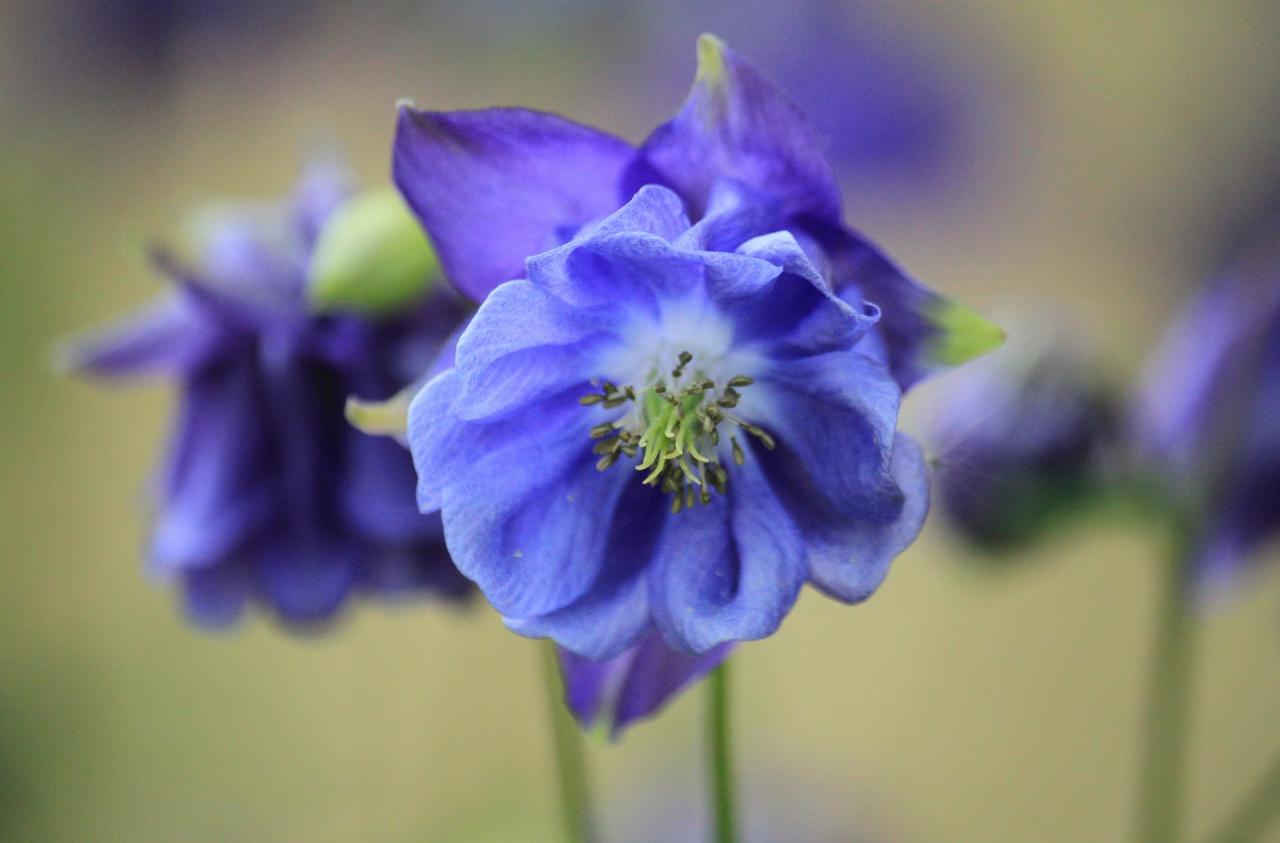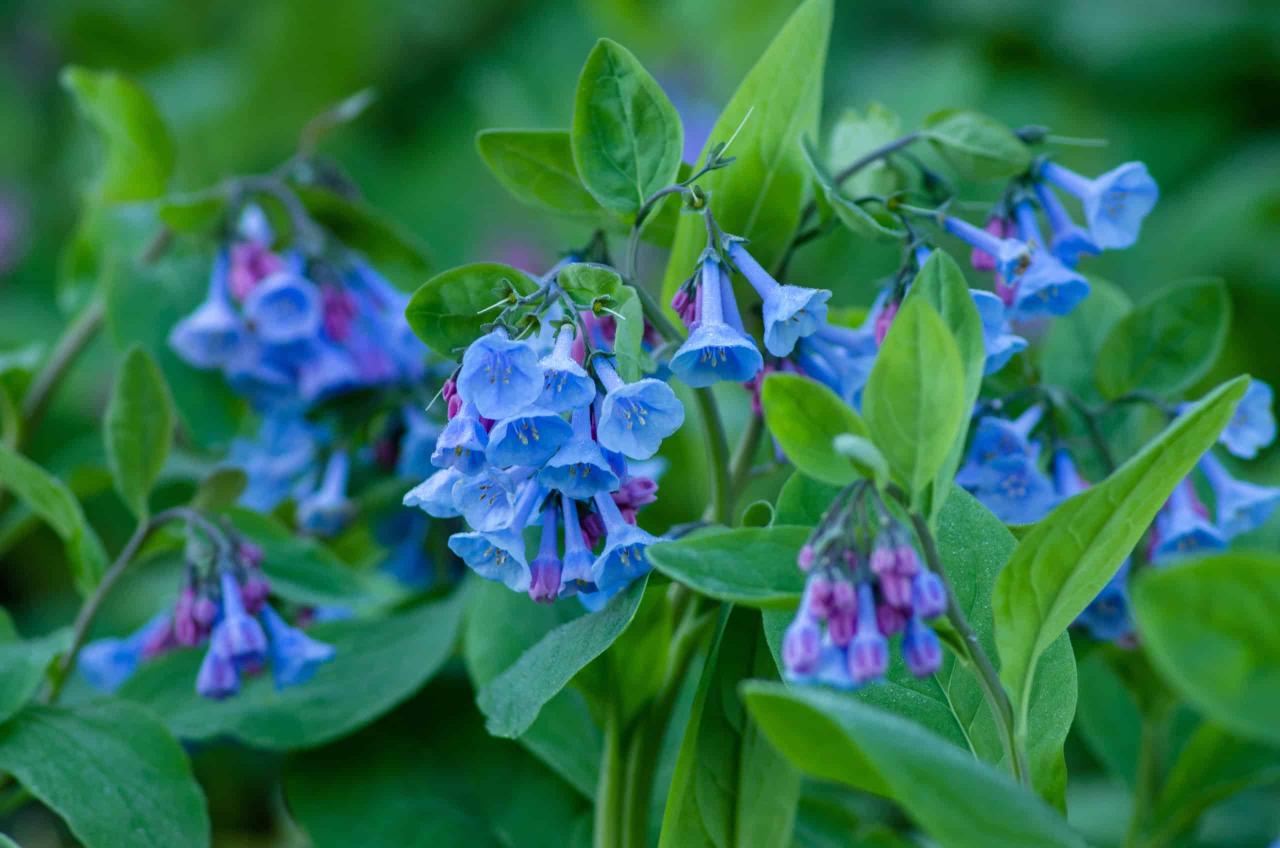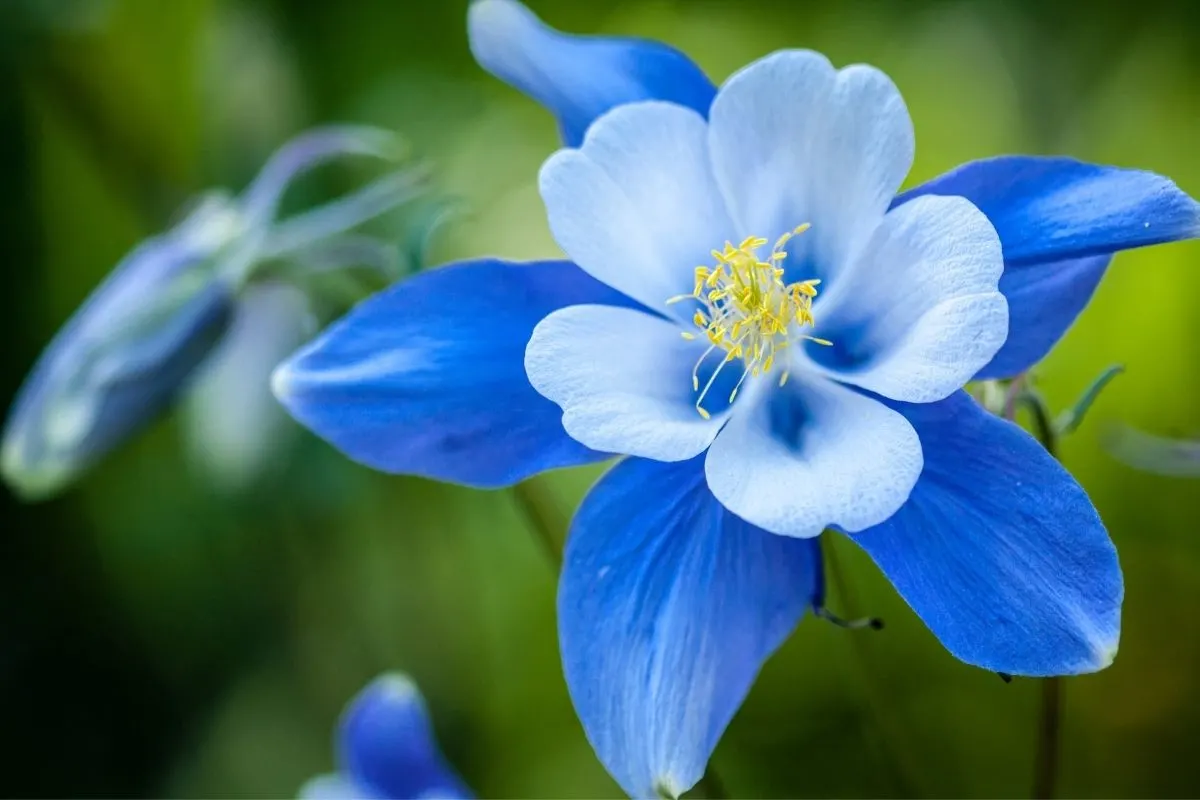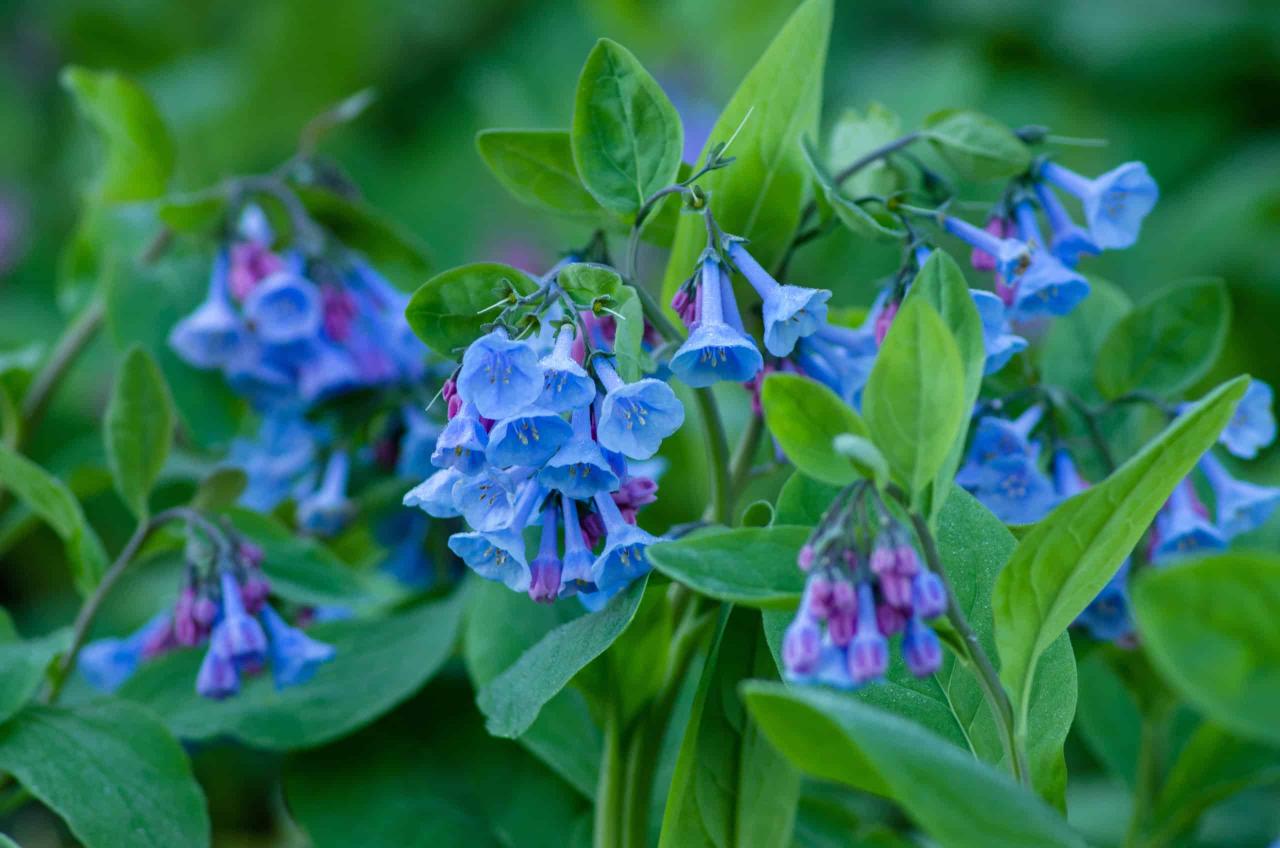Blue Flowered Plants: The Key to Unique and Beautiful Salad Dishes – imagine a salad that not only tastes delicious but also explodes with vibrant color. Blue-flowered plants offer a unique and captivating way to elevate your salad game.
From the delicate petals of borage to the vibrant hues of chicory, these edible flowers bring a touch of elegance and intrigue to any culinary creation.
Beyond their visual appeal, blue-flowered plants boast a range of flavors and textures, adding depth and complexity to your salads. Whether you’re looking for a subtle sweetness, a peppery kick, or a refreshing citrus note, there’s a blue-flowered plant to satisfy your taste buds.
These culinary treasures also offer a wealth of nutritional benefits, providing antioxidants, vitamins, and minerals to support your overall well-being.
Introduction: The Allure of Blue-Flowered Plants in Culinary Art
Blue-flowered plants have captivated culinary enthusiasts for centuries, adding a touch of elegance and intrigue to dishes worldwide. Their presence in food extends beyond mere aesthetics, as they hold a rich history and cultural significance. The visual appeal of blue flowers is undeniable.
They introduce a unique and vibrant color to salads, creating a striking contrast against the greens and yellows of traditional ingredients. This unexpected hue sparks curiosity and enhances the overall presentation, making the dish more inviting and memorable.
Examples of Blue-Flowered Plants Enhancing the Dining Experience
The incorporation of blue-flowered plants in salads transcends mere visual appeal. They offer a range of culinary benefits, adding complexity and depth to flavors. For example, the delicate floral notes of borage flowers complement the earthy tones of leafy greens, while the subtle sweetness of violas adds a touch of whimsy to the palate.
The inclusion of these plants also elevates the dining experience, offering a sense of adventure and discovery. The presence of edible flowers encourages diners to explore new flavors and textures, creating a more engaging and memorable culinary journey.
Edible Blue-Flowered Plants
The world of edible blue-flowered plants is a captivating realm, offering a symphony of flavors and textures that can transform your culinary creations. From the delicate petals of borage to the vibrant hues of chicory, these plants add a touch of elegance and intrigue to any dish.
Their vibrant blue color, reminiscent of the vast expanse of the sky, brings a sense of serenity and sophistication to the table. This exploration delves into the unique characteristics, culinary uses, and nutritional benefits of these extraordinary plants.
Edible Blue-Flowered Plants: A Culinary Exploration
This section provides a comprehensive list of edible blue-flowered plants, categorized by type, along with their unique characteristics, flavor profiles, and culinary uses.
Flowers
- Borage (Borago officinalis):Borage flowers, with their star-shaped blue blooms, possess a refreshing cucumber-like flavor. They are often used to garnish salads, cocktails, and desserts, adding a touch of elegance and a subtle sweetness. Borage flowers are also used in herbal teas for their calming properties.
- Butterfly Pea (Clitoria ternatea):This tropical vine boasts striking blue flowers that can be used to create vibrant blue teas, syrups, and even natural food coloring. The flowers have a slightly sweet, earthy flavor, reminiscent of green tea. They are also known for their potential cognitive benefits, such as improving memory and focus.
- Chicory (Cichorium intybus):Chicory flowers, with their delicate blue petals, offer a slightly bitter and earthy flavor. They are often used in salads, as a garnish, or in herbal teas. Chicory roots are also roasted and used as a coffee substitute.
- Cornflower (Centaurea cyanus):These vibrant blue flowers, often found in meadows and fields, possess a slightly sweet, slightly bitter flavor. They are used as a garnish for salads, desserts, and savory dishes, adding a touch of color and a subtle floral note.
- Forget-Me-Not (Myosotis sylvatica):These tiny blue flowers, with their delicate petals, offer a sweet, slightly honey-like flavor. They are often used as a garnish for desserts, salads, and savory dishes. Forget-me-nots are also used in herbal teas for their calming properties.
- Violets (Viola odorata):Violet flowers, with their delicate purple-blue petals, possess a sweet, slightly honey-like flavor. They are often used to garnish desserts, salads, and savory dishes, adding a touch of color and a subtle floral note. Violet leaves can also be used in salads or as a tea.
Herbs
- Blue Basil (Ocimum basilicum ‘Blue Spice’):Blue basil, with its vibrant blue leaves, offers a spicy, slightly peppery flavor, similar to traditional green basil. It is often used in salads, pesto, and sauces, adding a touch of color and a unique flavor dimension.
- Blue Yarrow (Achillea millefolium):Yarrow flowers, with their delicate blue petals, possess a slightly bitter, slightly pungent flavor. They are often used in salads, as a garnish, or in herbal teas. Yarrow is also known for its medicinal properties, such as its ability to reduce inflammation and promote wound healing.
- Blue Sage (Salvia officinalis ‘Blue Hill’):Blue sage, with its vibrant blue leaves, offers a savory, slightly peppery flavor, similar to traditional green sage. It is often used in sauces, stuffings, and roasted vegetables, adding a touch of color and a unique flavor dimension.
Vegetables
- Blue Potatoes:Blue potatoes, with their distinctive blue flesh, offer a slightly sweet, slightly nutty flavor. They are often used in salads, soups, and stews, adding a touch of color and a unique flavor dimension. Blue potatoes are also a good source of antioxidants.
- Blueberries (Vaccinium corymbosum):Blueberries, with their small, round blue fruits, offer a sweet, slightly tart flavor. They are often used in smoothies, muffins, pies, and jams. Blueberries are a good source of antioxidants and fiber.
Nutritional Information and Health Benefits
Edible blue-flowered plants are not only visually appealing but also packed with nutritional value. Many of these plants are rich in antioxidants, vitamins, and minerals, offering various health benefits.
- Antioxidants:Many blue-flowered plants, such as blueberries, cornflowers, and chicory, are rich in antioxidants, which help protect the body from damage caused by free radicals.
- Vitamins and Minerals:These plants are also good sources of vitamins and minerals, such as vitamin C, vitamin A, iron, and potassium.
- Anti-Inflammatory Properties:Some blue-flowered plants, such as yarrow and borage, have anti-inflammatory properties, which can help reduce inflammation throughout the body.
- Cognitive Benefits:Butterfly pea flowers are known for their potential cognitive benefits, such as improving memory and focus.
- Digestive Health:Some blue-flowered plants, such as chicory, can promote digestive health by stimulating the production of bile.
Culinary Uses
Edible blue-flowered plants offer a wide range of culinary possibilities, adding a touch of color, flavor, and nutritional value to your dishes.
Blue-flowered plants offer a unique and vibrant aesthetic to salad dishes, transforming them into edible works of art. Their colors add a touch of whimsy and sophistication, making them perfect for both casual and formal gatherings. To learn more about incorporating these captivating blooms into your culinary creations, explore The Best Ways to Use Blue Flowered Plants in Your Salad Recipes.
Whether you’re adding a sprinkle of edible flowers for visual appeal or using them to infuse your salad with a delicate flavor, blue-flowered plants are sure to elevate your dishes to a new level of beauty and taste.
- Salads:Blue-flowered plants, such as borage, chicory, and cornflowers, can add a vibrant touch of color and a unique flavor dimension to salads.
- Garnishes:The delicate petals of blue-flowered plants, such as violets, forget-me-nots, and cornflowers, can be used as a beautiful and flavorful garnish for desserts, salads, and savory dishes.
- Teas:Many blue-flowered plants, such as butterfly pea flowers, chicory, and yarrow, can be used to create flavorful and aromatic teas.
- Sauces and Soups:Blue basil and blue sage can be used to add a touch of color and a unique flavor dimension to sauces and soups.
- Desserts:The sweet, floral flavors of blue-flowered plants, such as violets and forget-me-nots, can be incorporated into desserts, such as cakes, cookies, and ice cream.
- Cocktails:The vibrant blue color of butterfly pea flowers can be used to create visually stunning and flavorful cocktails.
Incorporating Blue-Flowered Plants into Salad Dishes

The vibrant hues of blue-flowered plants can transform a simple salad into a captivating culinary masterpiece. Their unique color adds a touch of whimsy and elegance, while their subtle flavors complement a wide range of ingredients.
Blue-Flowered Plant Salad Combinations, Blue Flowered Plants: The Key to Unique and Beautiful Salad Dishes
A carefully curated selection of blue-flowered plants can enhance the visual appeal and taste of your salads. The following table showcases diverse salad combinations, highlighting the unique flavors and textures that these plants bring to the table.
Salad Name |
Blue-Flowered Plant |
Other Ingredients |
Dressing |
Flavor Pairings |
|---|---|---|---|---|
Mediterranean Blue Delight |
Borage |
Feta cheese, olives, cherry tomatoes, red onion, cucumber |
Lemon vinaigrette |
The sweet, cucumber-like flavor of borage complements the salty feta and tangy olives. |
Summertime Blue Symphony |
Chicory |
Strawberries, blueberries, walnuts, goat cheese |
Honey-balsamic vinaigrette |
The slightly bitter chicory balances the sweetness of the berries and the richness of the goat cheese. |
Asian Blue Fusion |
Butterfly Pea Flower |
Edamame, avocado, mango, cilantro |
Sesame-ginger dressing |
The delicate floral notes of butterfly pea flower enhance the savory flavors of the edamame, avocado, and mango. |
Springtime Blue Rhapsody |
Violets |
Arugula, spinach, shaved Parmesan cheese, toasted pine nuts |
Lemon-herb vinaigrette |
The sweet, slightly floral taste of violets complements the peppery arugula and the nutty flavor of the pine nuts. |
Tips for Incorporating Blue Flowers into Salads
To ensure your blue-flowered plants retain their vibrant color and texture, consider the following tips:
- Harvest at the Peak of Bloom:Pick the flowers when they are fully open and at their most vibrant. This ensures maximum color and flavor.
- Gently Wash and Dry:Rinse the flowers in cold water to remove any dirt or debris. Gently pat them dry with a clean towel.
- Add at the Last Minute:Incorporate the blue flowers into your salad just before serving to maintain their freshness and vibrant color.
- Avoid Overcrowding:Use blue-flowered plants sparingly to avoid overpowering the other ingredients in your salad. A few strategically placed blossoms can create a striking visual effect.
- Consider Texture:Some blue-flowered plants have delicate petals, while others have sturdier blooms. Choose flowers that complement the texture of the other ingredients in your salad.
Blue-Flowered Plants
The culinary world is embracing the beauty and versatility of blue-flowered plants, expanding their use beyond the salad bowl. These vibrant blossoms offer a unique spectrum of flavors and textures, adding an unexpected dimension to dishes and captivating the senses.
Culinary Applications Beyond Salads
Blue-flowered plants possess a captivating allure that extends beyond their visual appeal. They offer a diverse range of culinary applications, from garnishes and infusions to desserts, adding a touch of elegance and sophistication to any culinary creation.
While blue-flowered plants can add a touch of vibrancy to your salad bowls, creating a visually appealing and thriving lawn can be just as rewarding. If you’re looking to enhance your outdoor space, consider planting grass seed in September, as outlined in this helpful guide, How to Achieve a Thriving Lawn by Planting Grass Seed in September.
Once your lawn is flourishing, you can then focus on adding those eye-catching blue-flowered plants to your garden, creating a beautiful and balanced outdoor oasis.
Garnishes
Blue-flowered plants can transform a simple dish into a work of art. Their delicate petals and vibrant hues add a touch of whimsy and elegance to any culinary creation. For instance, a sprinkle of blue borage flowers atop a creamy soup or a scattering of chicory blossoms on a platter of grilled seafood can elevate the dish’s visual appeal and create a memorable dining experience.
Infusions
The floral essence of blue-flowered plants can be extracted through infusions, lending their unique flavors to beverages and culinary preparations. Infusing water, tea, or vinegar with blue flowers like cornflower or butterfly pea can create visually stunning and aromatic concoctions.
These infusions can be used to enhance the flavor of cocktails, desserts, or even savory dishes, adding a subtle yet distinctive touch.
Desserts
The delicate sweetness and vibrant hues of blue-flowered plants make them ideal for use in desserts. Blueberries, lavender, and chicory flowers can be incorporated into cakes, mousses, and ice creams, adding a touch of floral elegance and a subtle hint of sweetness.
For example, a lavender-infused panna cotta adorned with edible blue cornflower petals creates a visually striking and aromatically pleasing dessert.
Culinary Art and Food Styling
Blue-flowered plants play a vital role in culinary art and food styling. Their vibrant colors and delicate textures offer endless possibilities for creating visually stunning and innovative dishes. For example, a chef might arrange a platter of colorful vegetables with a scattering of blue borage flowers, creating a visually captivating and balanced composition.
Similarly, a dessert featuring a blue-hued butterfly pea flower-infused mousse topped with edible cornflower petals would be a testament to the artistic possibilities of these plants.
The use of blue-flowered plants in culinary art and food styling is not merely about aesthetics; it’s about creating a multi-sensory experience that engages the palate and the eye.
Growing and Sourcing Blue-Flowered Plants

Cultivating your own edible blue-flowered plants offers a unique and rewarding experience, allowing you to directly influence the quality and freshness of your ingredients. Sourcing these plants from reliable sources ensures you’re getting the best quality and supporting sustainable practices.
Growing Edible Blue-Flowered Plants at Home
Growing edible blue-flowered plants at home is a rewarding endeavor that allows you to control the quality and freshness of your ingredients. Here are some practical tips:
- Choose the right location:Most blue-flowered plants prefer full sun to partial shade. Select a location in your garden that receives at least six hours of sunlight daily. Ensure good drainage to prevent root rot.
- Prepare the soil:Amend your soil with compost or other organic matter to improve its fertility and drainage. The ideal pH for most blue-flowered plants is between 6.0 and 7.0.
- Start seeds or purchase seedlings:Many blue-flowered plants can be easily grown from seeds. Start them indoors six to eight weeks before the last frost date in your area. Alternatively, purchase seedlings from a local nursery or garden center.
- Water regularly:Keep the soil consistently moist but not waterlogged. Water deeply and infrequently, allowing the top inch of soil to dry out between waterings.
- Fertilize regularly:Apply a balanced fertilizer every few weeks during the growing season to provide essential nutrients for healthy growth and flowering.
- Harvest regularly:Harvest flowers when they are fully open and vibrant in color. This encourages the plant to produce more flowers.
Reliable Sources for Purchasing Blue-Flowered Plants
Sourcing your blue-flowered plants from reliable sources ensures you’re getting the best quality and supporting sustainable practices. Here are some options:
- Local farmers markets:Farmers markets are excellent sources for fresh, locally grown produce, including blue-flowered plants. You can often find a wide variety of plants, and you can speak directly with the farmers to learn about their growing practices.
- Specialty stores:Many specialty stores focus on edible flowers and herbs. These stores often carry a wider selection of blue-flowered plants than traditional grocery stores. You can find unique varieties and learn about their culinary uses.
- Online retailers:Online retailers offer a convenient way to purchase blue-flowered plants, with a wide selection and delivery options. Ensure you choose a reputable retailer with a good track record.
Sustainable Practices and Ethical Sourcing
Supporting sustainable practices and ethical sourcing is crucial when it comes to blue-flowered plants. This ensures the long-term health of the environment and the well-being of the people involved in the production process.
- Organic certification:Look for plants that are certified organic, indicating they were grown without the use of synthetic pesticides, herbicides, or fertilizers. This helps protect the environment and ensures the safety of your food.
- Fair trade practices:Choose plants that are sourced from farms that adhere to fair trade practices, ensuring fair wages and safe working conditions for workers. This promotes social responsibility and ethical sourcing.
- Local sourcing:Whenever possible, choose plants that are locally grown. This reduces the carbon footprint associated with transportation and supports local farmers and businesses.
Closing Notes

By incorporating blue-flowered plants into your salads, you can create a culinary masterpiece that tantalizes the senses and inspires creativity. From the garden to the table, these edible gems offer a symphony of flavors, colors, and textures, transforming your salads into works of art.
So, embrace the beauty and versatility of blue-flowered plants and embark on a culinary journey that celebrates the unique and the extraordinary.
FAQ Compilation: Blue Flowered Plants: The Key To Unique And Beautiful Salad Dishes
What are the best blue-flowered plants for beginners?
Some beginner-friendly blue-flowered plants include borage, chicory, and violas. They are relatively easy to grow and have a mild flavor that complements many salads.
How do I ensure blue-flowered plants retain their color in salads?
To preserve the vibrant color of blue-flowered plants, add them to your salad just before serving. Avoid using acidic dressings, as they can cause the flowers to fade.
Are all blue-flowered plants edible?
Not all blue-flowered plants are edible. It’s crucial to research and confirm the edibility of any plant before consuming it. Only use plants identified as safe for consumption.
